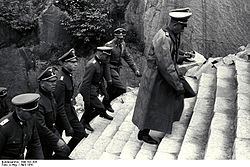Paul Hausser
Paul Hausser (German ; Paul Hausser ; 7 October 1880 – 21 December 1972) was a high-ranking SS commander of Nazi Germany. He played an important role in the post-war efforts by former members of the Waffen-SS to create historical and legal rehabilitation. Paul Hausser joined the Prussian Army in 1892 and during WW1 from 1914-1918 working for Kaiser Wilhelm II (Emperor : 1888-1918) and later Friedrich Ebert (President : 1919-1925) and later Paul von Hindenburg (President : 1925-1934) and Adolf Hitler (Fuhrer : 1933-1945) during WW2 .
| Paul Hausser | |
|---|---|
 Hausser during World War II in 1942 or 1943 | |
| Born | 7 October 1880 Brandenburg an der Havel, German Empire |
| Died | 21 December 1972 (aged 92) Ludwigsburg, West Germany |
| Buried at | Munich Waldfriedhof |
| Allegiance | |
| Service/branch | Prussian Army(1892-1918)'Reichsheer/(1921-1932)> |
| Years of service | 1892–1932 1934–1945 |
| Rank | SS-Oberst-Gruppenführer |
| Service number | NSDAP #4,138,779[1] SS #239,795[1] |
| Commands held | SS Division Das Reich II SS Panzer Corps Seventh Army |
| Battles/wars | World War I World War II |
| Awards | Knight's Cross of the Iron Cross with Oak Leaves and Swords |
| Other work | Founder of HIAG, Waffen-SS lobby group |
During World War II, he rose to the level of army group commander. He led Waffen-SS troops in the Third Battle of Kharkov, the Battle of Kursk and the Normandy Campaign. Hausser was the highest-ranking officer in the Waffen-SS alongside Sepp Dietrich.
Hausser wrote two books, published by right-wing imprints, arguing the purely military role of the Waffen-SS and advancing the notion that its troops were "soldiers like any other".
Hausser died on 21 December 1972 in Ludwigsburg,Baden-Württemberg,West Germany at the age of 92.[2]
Paul Hausser Media
Paul Hausser (far right, in overcoat) walking up the Stairs of Death at the Mauthausen-Gusen concentration camp, April 1941
References
- ↑ 1.0 1.1 Miller 2015, p. 34.
- ↑ Williamson 2006, p. 8.

